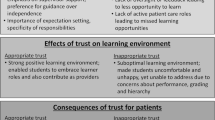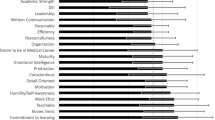Abstract
There has been increased attention to and emphasis on competency-based medical education and the transformation from highly supervised medical students towards independent, entrustable physicians. We explored how program directors (PDs) justify decisions about whether they would trust finishing Post Graduate Year 1 (PGY1) residents to care for the PD or a loved one. Using an end of year survey with validity evidence, we assessed PDs’ responses (Yes, No, Not Sure) and written comments about this entrustment decision for USUHS medical students from graduating classes of 2013–2015 (PGY1). We performed a qualitative inductive content analysis to identify themes in how PDs justified their decisions as well as descriptive statistics and a contingency table analysis to examine associations between trust decisions and election to membership in Alpha Omega Alpha (AOA), or conversely, referral to the Student Promotions Committee (SPC) for remediation. Qualitative analyses revealed five themes related to this trust decision about medical residents: personal, interpersonal, knowledge, competence, and developmental. Neither AOA status, nor SPC referral status was significantly associated with the trust measure, overall, but positive trust decisions were significantly higher among those elected to AOA than in those who were not. Positive trust decisions were significantly associated with AOA status but negative trust decisions were not significantly associated with referral to the SPC. This study offers insights into what attributes may underpin trust decisions by PDs. Our findings suggest that PDs’ frequent use of personal and interpersonal characteristics to justify trust decisions contrasts with the use of clinical and knowledge based assessments during undergraduate medical education (UME), and emphasize the importance of critical intrinsic abilities.
Similar content being viewed by others
References
Alpha Omega Alpha Honor Medical Society Uniformed Services Chapter Bethesda, MD (n.d.) Retrieved September 10, 2017, from http://www.usuaoa.org/faq/.
Andolsek, K. M. (2016). Improving the medical student performance evaluation to facilitate resident selection. Academic Medicine,91(11), 1475–1479.
Badyal, D. K., & Singh, T. (2017). Learning theories: The basics to learn in medical education. International Journal of Applied Basic Medical Research,7, S1–S3.
Bandura, A. (1977). Social learning theory. Englewood Cliffs, NJ: Prentice Hall.
Borowitz, S. S., Saulsbury, F. T., & Wilson, W. G. (2000). Information collected during the residency match process does not predict clinical performance. Archives of Pediatric Adolescent Medicine,154(3), 256–260.
Boud, D. (1990). Assessment and the promotion of academic values. Studies in Higher Education,15(1), 101–111.
Bowen, G. A. (2008). Naturalistic inquiry and the saturation concept: A research note. Qualitative Research,8(1), 16.
Canterbury, R. J. (2016). Curriculum Inventory in Context—Effect of USMLE on U.S. Medical Education, 3(7). Washington, DC: Association of American Medical Colleges.
Chickering, A. W., & Reisser, L. (1993). Education and identity (2nd ed.). San Francisco, CA: Jossey-Bass.
Choo, K. J., Arora, V. M., Barach, P., Johnson, J. K., & Farnan, J. M. (2014). How do supervising physicians decide to entrust residents with unsupervised tasks? A qualitative analysis. Journal of Hospital Medicine,9(3), 169–175.
Creswell, J. W., & Plano-Clark, V. L. (2007). Designing and conducting mixed methods research. Thousand Oaks, CA: Sage.
Dong, T., Durning, S. J., Gilliland, W. R., Swygert, K. A., & Artino, A. R. (2015). Development and initial validation of a program director’s evaluation form for medical school graduates. Military Medicine,180(4), 7.
Durning, S. J., Artino, A. R., Dong, T., Cruess, D. F., Gilliland, W. R., DeZee, K. J., et al. (2012). 40 years of military education: An overview of the long-term career outcome study (LTCOS). Military Medicine,177(Supplement 3), 3–6.
Durning, S. J., Pangaro, L. N., Lawrence, L. L., Waechter, D., McManigle, J., & Jackson, J. L. (2005). The feasibility, reliability, and validity of a program director’s (supervisor’s) evaluation form for medical school graduates. Academic Medicine,80(10), 5.
Erikson, E. (1964). Insight and responsibility. New York: Norton.
Evans, N. J., Forney, D. S., & Guido-DiBrito, F. (1998). Student development in college: Theory, research and practice. San Francisco, CA: Jossey-Bass.
Favreau, M. A., Tewksbury, L., Lupi, C., Cutrer, W. B., Jokela, J. A., & Yarris, L. M. (2017). Constructing a shared mental model for faculty development for the Core Entrustable Professional Activities for Entering Residency. Academic Medicine,92(6), 759–764.
Flexner, A. (1910). Medical education in the United States and Canada: A report to the Carnegie Foundation for the Advancement of Teaching. Bulletin No. 4., New York, NY: The Carnegie Foundation.
Fusch, P. I., & Ness, L. R. (2015). Are we there yet? Data saturation in qualitative research. The Qualitative Report,20(9), 9.
Hauer, K. E., ten Cate, O., Boscardin, C., Irby, D. M., Iobst, W., & O’Sullivan, P. S. (2014). Understanding trust as an essential element of trainee supervision and learning in the workplace. Advances in Health Sciences Education Theory and Practice,19(3), 435–456.
Irby, D. (2011). Educating physicians for the future: Carnegie’s calls for reform. Medical Teacher,33(7), 547–550.
Jayakumar, K. L. (2016). Numerical USMLE Step 1 scores are still important in the selection of residency applicants. Academic Medicine,91(11), 1470–1471.
Kamel-El Sayed, S., & Loftus, S. (2018). Using and combining learning theories in medical education. Medical Science Educator,28(1), 255–258.
Lave, J., & Wenger, E. (1991a). Situated learning in communities of practice. In L. Resnick, J. Levine, & S. Teasley (Eds.), Perspectives on socially shared cognition (pp. 63–82). Washington, DC: American Psychological Association (APA).
Lave, J., & Wenger, E. (1991b). Situated learning: legitimate peripheral participation. Cambridge: Cambridge University Press.
Lypson, M., & Simpson, D. (2011). It all starts and ends with the program director. Journal of Graduate Medical Education,3(2), 261–263.
Maxwell, J. A. (2010). Using numbers in qualitative research. Qualitative Inquiry,16(6), 475–482.
McDevitt, T. M., & Omrod, J. E. (2004). Child development: Educating and working with children and adolescents (2nd ed.). Upper Saddle River, NJ: Pearson.
Mehta, N. B., Hull, A., & Young, J. (2016). More on how USMLE Step 1 scores are challenging academic medicine. Academic Medicine,91, 609.
National Residency Matching Program. (2014). Data Release and Research Committee: Results of the 2014 NRMP Program Director Survey. Washington, DC: National Resident Matching Program.
Pock, A. R., Pangaro, L. N., Green, C. B., & Laughlin, L. (2013). Undergraduate medical education: Past, present, and future. Military Medicine,178(5), 474–478.
Quintero, G. A., Vergel, J., Arredondo, M., Ariza, M. C., Gomez, P., & Pinzon-Barrios, A. M. (2016). Integrated medical curriculum: Advantages and disadvantages. Journal of Medical Education and Curriculum Development,3, 133–137.
Rajan, S. J., Jacob, T. M., & Sathyendra, S. (2016). Vertical integration of basic science in final year of medical education. International Journal of Applied Medical Research,6(3), 182–185.
Rosenthal, S., Howard, B., Schlussel, Y. R., Lazarus, C. J., Wong, J. G., Moutier, C., et al. (2009). Does student membership in the Gold Humanism Honor Society influence selection for residency? Journal of Surgical Education,66(6), 308–313.
Schumacher, D. J., Poynter, S., Burman, N., Elliott, S. P., Barnes, M., Gellin, C., et al. (in press). Justifications for discrepancies between competency committee and program director recommended resident supervisory roles. Academic Pediatrics.
Schuwirth, L. W., & Van der Vleuten, C. P. (2011). Programmatic assessment: From assessment of learning to assessment for learning. Medical Teacher,33, 478–485.
Sheu, L., O’Sullivan, P. S., Aagaard, E. M., Tad-y, D., Harrell, H. E., Kogan, J. R., et al. (2016). How residents develop trust in interns: A multi-institutional mixed-methods study. Academic Medicine,91(10), 1406–1415.
Sterkenberg, A., Barach, P., Kalkman, C., Gielen, M., & ten Cate, O. (2010). When do supervising physicians decide to entrust residents with unsupervised tasks? Academic Medicine,85(9), 1408–1417.
Strauss, A., & Corbin, J. (1998). Basics of qualitative research: Grounded theory procedures and techniques (2nd ed.). Thousand Oaks, CA: Sage.
ten Cate, O. (2005). Entrustability of professional activities and competency-based training. Medical Education,39(12), 1176–1177.
ten Cate, O. (2013). Nuts and bolts of entrustable professional activities. Journal of Graduate Medical Education,5(1), 157–158.
ten Cate, O. (2016). Entrustment as assessment: Recognizing the ability, the right, and the duty to act. Journal of Graduate Medical Education,8(2), 261–262.
ten Cate, O., & Billett, S. (2014). Competency-based medical education: Origins, perspectives and potentialities. Medical Education,48(3), 325–332.
ten Cate, O., Hart, D., Ankel, F., Busari, J., Englander, R., Glasgow, N., et al. (2016). Entrustment decision making in clinical training. Academic Medicine,91(2), 191–198.
ten Cate, O., & Scheele, F. (2007). Viewpoint: Competency-based postgraduate training: Can we bridge the gap between theory and clinical practice? Academic Medicine,82(6), 542–547.
ten Cate, O., Snell, L., & Carraccio, C. (2010). Medical competence: The interplay between individual ability and the health care environment. Medical Teacher,32(8), 669–675.
Torre, D. M., Daley, B. J., Sebastian, J. L., & Elnicki, D. M. (2006). Overview of current learning theories for medical education. The American Journal of Medicine,119(10), 903–907.
Ulmer, C., Wolman, D., & Johns, M. (Eds.). (2008). Resident duty hours: Enhancing sleep, supervision, and safety. Washington, DC: National Academies Press.
United States Medical Licensing Examination. (2019). Invitational Conference on USMLE Scoring (InCUS). Retrieved July 28, 2019, from https://www.usmle.org/inCus/.
Vygotsky, L. (1978). Mind in society. Cambridge, MA: Harvard University Press.
Wenger, E. C., & Snyder, W. M. (2000). Communities of practice: The organizational frontier. Harvard Business Review,R00110, 139–145.
Author information
Authors and Affiliations
Corresponding author
Additional information
Publisher's Note
Springer Nature remains neutral with regard to jurisdictional claims in published maps and institutional affiliations.
Disclaimer The opinions and assertions contained in this manuscript are strictly the private opinions of the authors, and not those of the Uniformed Services University of the Health Sciences, the Department of Defense (DoD), or the United States Government.
Rights and permissions
About this article
Cite this article
Yoon, M.H., Kurzweil, D.M., Durning, S.J. et al. It’s a matter of trust: exploring the basis of program directors’ decisions about whether to trust a resident to care for a loved one. Adv in Health Sci Educ 25, 691–709 (2020). https://doi.org/10.1007/s10459-019-09953-x
Received:
Accepted:
Published:
Issue Date:
DOI: https://doi.org/10.1007/s10459-019-09953-x




